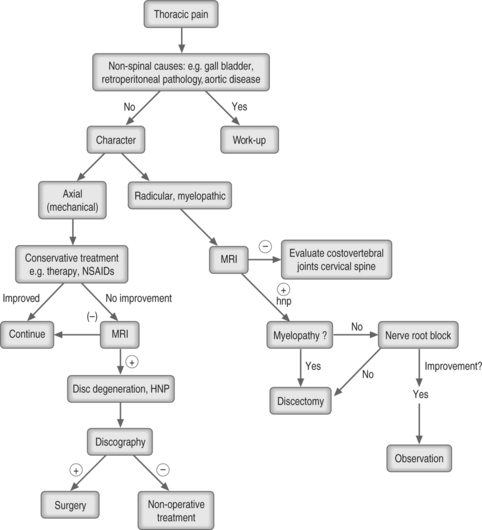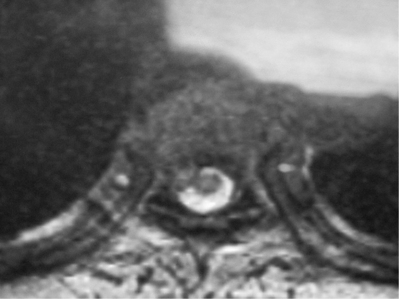CHAPTER 75 Surgery: Thoracic Disc Disease
INTRODUCTION
Compared with the cervical and lumbar spine, degenerative thoracic disc pathology is relatively uncommon. When present, however, it can produce symptoms of axial or mechanical back pain, radiculopathy, or myelopathy. Surgery is effective for treating many forms of thoracic disc pathology that have failed nonoperative treatment.
INDICATIONS
Indications for surgical intervention include myelopathy, progressive neurologic deficit, confirmed radiculopathy, or mechanical axial back pain persisting at an unacceptable level in those who have failed adequate nonsurgical treatment (Fig. 75.1). If surgery is contemplated, it should be directed at the levels with confirmed pathology as seen on axial diagnostic imaging.
Thoracic disc herniations are the most common manifestation of thoracic disc degeneration requiring surgical treatment (Fig. 75.2). With the advent of magnetic resonance imaging (MRI) the frequency with which the diagnosis of a herniated disc is made has increased. It is important to remember, however, that thoracic disc herniations can be seen in an otherwise asymptomatic population. Wood et al.1 found, in their study of asymptomatic individuals, that 37% of those studied had at least one herniation, half of whom had multiple protrusions and many with actual deformation of the spinal cord. In addition, because of the relative paucity of classic clinical findings such as those seen with herniations in the lumbar spine, complaints can often be vague, especially when it is principally axial pain. Historically, a large number of other pathologic conditions including not only lumbar disc disease and neurogenic claudication, but also cardiac, abdominal (e.g. gall bladder), intrathoracic pathologies, and even multiple sclerosis have been mistakenly diagnosed. When myelopathy is found, cervical involvement should be evaluated to rule out concomitant pathology.
Making the correct diagnosis begins with MRI, especially for evaluating mechanical back pain. When evaluating spinal cord encroachment, myelography with computed tomography (CT) is another option, but it is invasive, although its sensitivity and specificity are comparable with that of MRI.2,3 CT can also be used to describe calcifications at the disc level, or ossification of the posterior longitudinal ligament or ligamentum flavum. Defining the precise pathology is important, as it will often influence the surgical approach. Many feel that obtaining both an MRI as well as a CT-myelogram is indicated for those scheduled for surgery.
In instances where the presentation is less clear – typically mechanical or axial pain – further confirmation of the pathology can be obtained with discographic evaluation. When performed by experienced and skilled technicians, it is a safe and reliable procedure to confirm and locate the site of axial thoracic pain.4,5 It can be especially useful in situations of multiple levels of thoracic pathology with varying grades of disc herniations. A strict contraindication, however, is a large prolapse with spinal cord deformation wherein the instillation of a saline contrast would run the risk of further cord compression. Thus, discography is probably somewhat limited to those situations of smaller or no actual disc protrusion.
Stay updated, free articles. Join our Telegram channel

Full access? Get Clinical Tree










